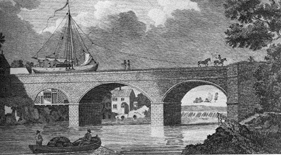Canals were needed for the Industrial Revolution which was creating huge amounts of heavy produce which had to be moved. Roads simply could not handle such weights and the vehicles needed to move this produce did not exist. Canals were the answer to moving heavy objects large distances.
Canals were man-made rivers which were deep enough to cope with barges which were capable of moving nearly forty tonnes of weight. This was far more than a pack of mules could carry or a horse and carriage.
The man most associated with early canals was the Duke of Bridgewater. He owned coal mines in Lancashire but he needed to get the coal to the big market of Manchester which was nearly six miles away. The duke gave the task of designing and building the canal to James Brindley – an engineer who at this time had never built a canal before. As such, the duke was taking a great risk and he even had to borrow £25,000 to pay for the project – which was a vast sum of money then.
It took two years to build the canal which was completed in 1761. The canal had a series of tunnels which were linked directly to the coal mines. But its most famous section was the Barton Aqueduct which took the canal over the River Irwin.

The Barton Aqueduct
The canal was a huge success as it made the duke a lot of money
The price of coal fell in Manchester by 50% therefore making it cheaper and the cheaper it was the more was sold. People could not get enough of the duke’s coal
Brindley gained fame and more work
Other people saw the success of the Bridgewater Canal and decided to do likewise thus opening up Britain even more with a series of canals that linked the major industrial centres of Britain.
Brindley designed and built nearly 400 miles of canals. His biggest project was the Trent and Mersey canal which linked two major industrial areas of Britain. He also found ways to get around certain natural problems which would make canals redundant.
Canals had to be perfectly flat or else the water would simply run away. Likewise, the canals had to be waterproofed…….for obvious reasons. Brindley used an old process called puddling which lined the sides and bottom of a canal with clay mixed with water. He tried to go around hills where possible but if this was impossible he used locks to move a canal barge up or down before it returned to a flat level.
Canals could make those who invested in them vast sums of money. In the 1790’s so-called “canal mania” took place when people invested their money into practically every canal project. Canals were good at moving fragile goods such as pottery and also heavy goods such as coal. They were actually faster than carriages and pack mules as once a horse got a barge moving, its own momentum would keep it going at a decent pace. By 1840, there were nearly 4,500 miles of canals in Britain. Yet within years their great days were over. Why ?
Different builders build different size canals so that different size canal barges were needed. One canal barge might not be able to use a canal built by another engineer. This, naturally, limited them a great deal.
Better roads had lead to better horse drawn carriages being developed. These were a lot faster than barges and passengers used these in preference to canals.
Food that rotted quickly could not be transported by canal as refrigerated units had yet to be invented.
Canals could freeze up in winter and a hot summer could literally dry them out if they were not topped up with water on a regular basis.
Trains were soon to take over the role played by the canals.![]()